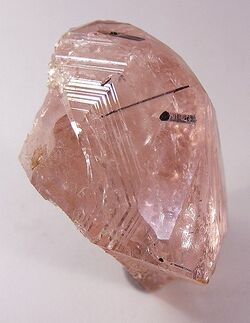Chemistry:Morganite (gem)
| Morganite | |
|---|---|
 Morganite from Brazil with inclusions of black schorl | |
| General | |
| Category | beryl[1] |
| Formula (repeating unit) | Be3Al2(Si6O18) |
| Identification | |
| Color | Pink |
| Mohs scale hardness | 7.5 to 8 |
Morganite is an orange or pink variety of beryl and is also a gemstone.[2] Morganite is mined in Brazil, Afghanistan, Mozambique, Namibia, the United States, and Madagascar .[3]
Morganite has grown in popularity since 2010.[2] Brides and CNN have listed it as a possible alternative to diamond for engagement rings.[4][5]
Name
Morganite is named(1911) after J. P. Morgan.[6]
Morganite is also known as pink beryl, rose beryl, pink emerald, and "cesian (or caesian) beryl".[7]
Characteristics
The pink color of morganite is attributed to Mn2+ ions.[7] Morganite is pleochroic; when it is viewed down its crystallographic axis the color is more pink.
In comparison to emerald, morganite lacks inclusions and fractures, thus making it more durable than emerald.[2]
History
Pink beryl of fine color and good sizes was first discovered on an island off the coast of Madagascar in 1910.[8] It was also known, with other gemstone minerals, such as tourmaline and kunzite, at Pala, California. In December 1910, the New York Academy of Sciences named the pink variety of beryl "morganite" after financier J. P. Morgan.[8]
On October 7, 1989, one of the largest gem morganite specimens ever uncovered, eventually called "The Rose of Maine", was found at the Bennett Quarry in Buckfield, Maine, US.[9] The crystal, originally somewhat orange in hue, was 23 cm (9 in) long and about 30 cm (12 in) across, and weighed (along with its matrix) just over 50 pounds (23 kg).[10]
Before 2011, morganite was unknown in many jewelry stores. But, recently morganite has been increasing in popularity.[2]
Value and popularity
According to a 2017 survey, morganite is the second most popular non-diamond stone, after sapphire. A single carat of morganite can cost about $300.[11]
Morganite is one of the rarest members of the beryl family, second only to red beryl. Due to the scarcity of morganites, especially those of high quality, they tend to be among the most expensive per carat.[6] Ones that are deep pink in color tend to be the most valuable.[12]
References
- ↑ "Morganite". https://www.mindat.org/min-2783.html.
- ↑ 2.0 2.1 2.2 2.3 "Morganite: The orange to pink gem with growing popularity". https://geology.com/gemstones/morganite/.
- ↑ "Morganite Description" (in en). https://www.gia.edu/morganite-description.
- ↑ "8 Diamond Alternatives to Consider for Your Engagement Ring" (in en). https://www.brides.com/diamond-alternatives-5186406.
- ↑ Murden, Banu Ibrahim,Kiana (2021-05-18). "Planning to propose? Here are 23 expert-approved rings worth buying" (in en). https://www.cnn.com/2021/05/18/cnn-underscored/best-engagement-rings/index.html.
- ↑ 6.0 6.1 Oldershaw, Cally (2003) (in en). Firefly Guide to Gems. Firefly Books. pp. 128. ISBN 978-1-55297-814-6. https://books.google.com/books?id=wm_X_LzoN-cC&q=morganite&pg=PA128.
- ↑ 7.0 7.1 "Color in the beryl group". California Institute of Technology. http://minerals.caltech.edu/FILES/Visible/BERYL/Index.htm.
- ↑ 8.0 8.1 "Gem named for Morgan; Newly discovered pink beryl is to be known as Morganite". The New York Times. 1910-12-06. https://timesmachine.nytimes.com/timesmachine/1910/12/06/102052382.pdf.
- ↑ Harrison, Donald K.; Anderson, Walter; Foley, Michael E. (1990). "The Mineral Industry of Maine". Minerals yearbook 1990. 2. US Bureau of Mines. p. 237. ISBN 978-0-160-38183-6. http://images.library.wisc.edu/EcoNatRes/EFacs2/MineralsYearBk/MinYB1990v2/reference/econatres.minyb1990v2.dharrison3.pdf.
- ↑ "The Rose of Maine". Maine Geological Survey. October 6, 2005. http://maine.gov/doc/nrimc/mgs/explore/minerals/guide/chapter5/bennett-3.htm. Image of "The Rose of Maine" at the site of its discovery.
- ↑ Keiles, Jamie Lauren (2018-12-04). "The pink engagement ring gemstone that everyone is buying but nobody is talking about" (in en). https://www.vox.com/the-goods/2018/12/4/18126188/morganite-engagement-ring-gemstone-diamond-alternative.
- ↑ Grande, Lance; Augustyn, Allison (2009-11-15) (in en). Gems and Gemstones: Timeless Natural Beauty of the Mineral World. University of Chicago Press. pp. 131. ISBN 978-0-226-30511-0. https://books.google.com/books?id=RnE9Fa4pbn0C&q=Morganite&pg=PA131.
 |

